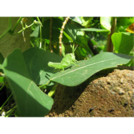
In this lesson students will explore the physical characteristics of insects and how they camouflage themselves to avoid being eaten by predators.
- Subject:
- Life Science
- Material Type:
- Lesson Plan
- Author:
- Out Teach
- Date Added:
- 07/22/2021

In this lesson students will explore the physical characteristics of insects and how they camouflage themselves to avoid being eaten by predators.
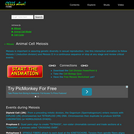
Meiosis is important in assuring genetic diversity in sexual reproduction. Use this interactive animation to follow Meiosis I (reduction division) and Meiosis II in a continuous sequence or stop at any stage and review critical events.
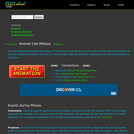
This animation demonstrates the stages of mitosis in an animal cell. Use the control buttons in the upper left to run the complete animation. Click on any intermediate stage (for example, Anaphase), and see a representative still frame.
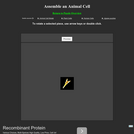
Try your hand at assembling the following animal cell jigsaw puzzle created with an image from CELLS alive! This puzzle is 32 pieces and generally takes a few minutes to solve. Have fun!

Animals are an important part of the ecosystem. They help to maintain the balance of nature by providing food for other animals, by pollinating plants, and by dispersing seeds. Animals are also important to humans, as they provide us with food, clothing, and companionship.However, animals are facing a number of threats, including habitat loss, climate change, and pollution. These threats are causing the decline of many animal species, and some species are even facing extinction.It is important to conserve animals and to protect their habitats so that future generations can enjoy them.

Animals are an important part of the ecosystem. They help to maintain the balance of nature by providing food for other animals, by pollinating plants, and by dispersing seeds. Animals are also important to humans, as they provide us with food, clothing, and companionship.However, animals are facing a number of threats, including habitat loss, climate change, and pollution. These threats are causing the decline of many animal species, and some species are even facing extinction.It is important to conserve animals and to protect their habitats so that future generations can enjoy them.
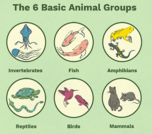
4th Grade Elementary school CLIL lesson about the Animal Classes
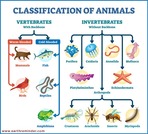
7th Grade Elementary school CLIL lesson about the Animal Classes

An introduction to how animals communicate.

How do animals communicate in the environment? And how does this affect their behaviour? Learn about animal communication in this GCSE / K12 Ecology video from the Virtual School.
Are you a passionate teacher who would like to reach tens of thousands of learners?
Get in touch: vsteam@fusion-universal.com
Find out more: http://www.thevirtualschool.com
Follow us: http://www.youtube.com/virtualschooluk
Friend us: http://www.facebook.com/virtualschooluk
Teach the world.
This video is distributed under a Creative Commons License:
Attribution-NonCommercial-NoDerivs
CC BY-NC-ND
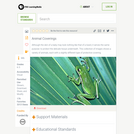
It takes a thick skin to withstand the hardships that life has to offer. This collection of images shows a variety of animals, each with a slightly different type of protective covering.
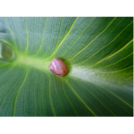
Students will explore the outdoor classroom in pairs looking for evidence of animal life and imagining what types of animals might live in and around the area.

This site is a searchable encyclopedia of thousands of photos, descriptions, sound recordings, and other information about individual animal species. Find out about amphibians, arthropods, birds, fishes, insects, mammals, mollusks, reptiles, and sharks. Explore special features on mammals, skulls, and frog calls. Students are invited to contribute.

This resource was created by Ross Renfro, in collaboration with Dawn DeTurk, Hannah Blomstedt, and Julie Albrecht, as part of ESU2's Integrating the Arts project. This project is a four year initiative focused on integrating arts into the core curriculum through teacher education, practice, and coaching.
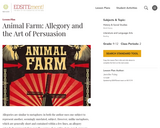
Allegories are similar to metaphors: in both the author uses one subject to represent another, seemingly unrelated, subject. However, unlike metaphors, which are generally short and contained within a few lines, an allegory extends its representation over the course of an entire story, novel, or poem. This lesson plan will introduce students to the concept of allegory by using George Orwell’s widely read novella, Animal Farm, which is available on Project Gutenberg.
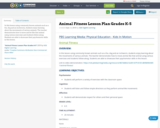
In this lesson using commonly known animals such as a fox, dog and an inchworm, students enjoy learning about the movements of various animals. The teacher demonstrates how to move and be like that animal using various exercises and students follow along. Students are able to showcase their psychomotor skills in this lesson.
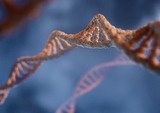
This lesson presents an overview of the role of genetics, breeding, and reproduction in animal agriculture. Learners will become familiar with fundamentals of genetics, complete a Punnett square, understand phenotypes and genotypes, identify parts of reproductive systems, and discuss breeding systems used in the animal industry. This represents a portion of the Introduction to Agriculture, Food, and Natural Resources (AFNR) series in Nebraska middle and high school agricultural education.

In this lesson, students will use teacher provided materials to create an animal habitat. They will work in groups and be assigned a habitat. Each group will need to include plants and animals found in their habitat. Students will present their finished project to the class and each member will give a fact about their habitat. The teacher will assess student understanding based on the models and presentations.

This is a lesson that can be used to teach beginning Introduction to Agriculture students about the types of drugs we administer to animals. Students then get to complete a hands-on lab activity where they learn about and demonstrate four types of injections.
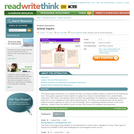
Supporting inquiry-based research projects, the Animal Inquiry interactive invites elementary students to explore animal facts and habitats using writing prompts to guide and record their findings.